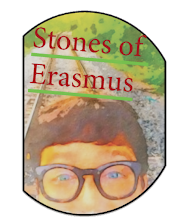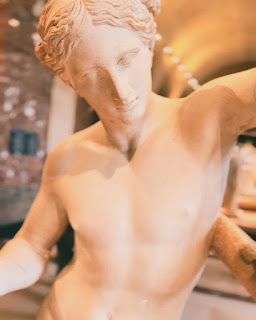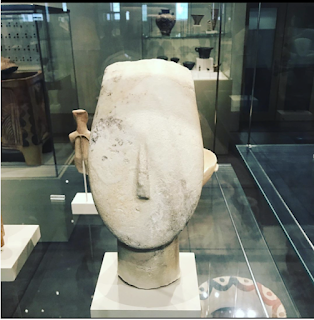Hey, y’all. I’m at the Metropolitan Museum of Art today, standing in front of a captivating marble sculpture that tells the dramatic myth of Alpheus and Arethusa. This piece, crafted by Battista di Domenico Lorenzi in the 17th century for a fountain at Alano Bandini’s villa near Florence, now serves as the centerpiece of a Spanish-style patio beside the Met’s main academic library. The scene depicts the river-god Alpheus lunging after Arethusa, who embodies the familiar trope of the relentless pursuer and the hunted maiden. According to legend, when Alpheus nearly captures her, Arethusa calls upon the goddess Diana (Artemis) for help. In response, Diana transforms her devotee into a living fountain, a moment immortalized in marble, where desperation, divine intervention, and metamorphosis converge.
Hi, I’m Greig — welcome! Here you’ll find sharp writing, creative ideas, and standout resources for teaching, thinking, making, and dreaming in the middle and high school ELA and Humanities classroom (Grades 6–12).
Showing posts with label Greek. Show all posts
Showing posts with label Greek. Show all posts
20.6.25
From Marble to Myth: A Turnkey Alpheus & Arethusa Lesson (with Adonis, Hyacinth, and More)
I have created educational resources to assist in teaching the myth of Alpheus and Arethusa. I included it in a complete, ready-to-go lesson plan on Io and Other Lovers and other tales of pursuit from Greek mythology! Let me guess—you're interested in and piqued by the story, so I will send you the materials if you buy me a cup of coffee.
 I am an educator and a writer. I was born in Louisiana and I now live in the Big Apple. My heart beats to the rhythm of "Ain't No Place to Pee on Mardi Gras Day". My style is of the hot sauce variety. I love philosophy sprinkles and a hot cup of café au lait.
I am an educator and a writer. I was born in Louisiana and I now live in the Big Apple. My heart beats to the rhythm of "Ain't No Place to Pee on Mardi Gras Day". My style is of the hot sauce variety. I love philosophy sprinkles and a hot cup of café au lait.
20.3.24
Sully Wing Secrets: Louvre's Greek and Egyptian Wonders
Discover a teacher's unique Louvre encounters, from Greek beauty to Egyptian relics. Explore beyond Mona Lisa to uncover the Louvre's heart.
 |
| (2) Apollon Sauroctone |
 |
| (1) Éphèbe |
You can't expect to tour the Louvre and see it all. I've visited the museum three times; most recently this past February as a high school English teacher on a London and Paris school trip. My previous visits were in 2000 and 2001 as a college student. During the first of those trips, I explored the Denon wing, which houses the Louvre's iconic treasures — the Mona Lisa, the Winged Victory of Samothrace, the Coronation of Napoleon, and all those wonderful works of art. I was in awe, though I do recall the Mona Lisa looking more like a postcard (she still does, but we adore you, La Joconde!).
On this third visit, I began in the basement of the Sully wing and worked my way up, which proved to be immensely rewarding. And I did not even catch nary a glimpse of Leonardo's lady nor did I see the Nike (they live in my heart). Where the Éphèbe (1) and Apollo Sauroctone (2) reside is a vast collection of Greco-Roman sculpture, including the Venus de Milo. I was struck by the youthful Narcissus, whom I initially mistook for an athlete — he epitomizes Greek beauty and the stylized classical loveliness associated with the young and svelte. Similarly, there is the Apollo — it seems the gods enjoyed odd, vain acts like slaying lizards — apparently, this depicts Apollo as a protector. I had some knowledge of this piece prior to my visit, so seeing it in person was a delight.
Deep in the Sully wing lie the remnants of the Louvre's past life as a fortress before it became a royal palace and now a museum. The dungeon, curiously, serves as the storage for artifacts related to French history and the story of the Louvre complex. Here, I encountered a majestic sculpture representing the river (3) — there are actually two, but here we speak of one: the Seine. And I must say, I was captivated by him.
The Louvre's Egyptian wing is dizzying, with fifteen thousand objects from their massive half-a-million-piece collection. Even after seeing Egyptian art in numerous museums, the Louvre's assemblage feels personal and well-organized. The procession of sphinxes (4) in Room 327 was a charming touch — I half-expected one to spring to life and pose the classic riddle about the creature that walks on four legs in the morning, two in the afternoon, and three in the evening.
A three-thousand-year-old Egyptian statue (5), likely once part of a fierce work, is displayed, and it caught my attention, especially because of its eyes. It reminded me of how Percy Bysshe Shelley envisions the sculptor of Rameses II (now in the British Museum), meticulously carving the pharaoh's visage, well aware of the emperor's demands for precision.
And finally, I returned to that room that first captured my heart — Room 344 — where a statue of Zeus, or technically Jupiter (6) (since it's a Roman piece), stands from the second century. And, goodness, what a figure he cuts!
![Un fleuve Barye, Antoine Louis. Un fleuve. 19th century, France. Musée du Louvre, Department of Sculptures of the Middle Ages, Renaissance, and Modern Times, inventory number RF 1560 & RF 1561. Louvre Museum, Sully, [HIST LOUVRE] Salle 134 - Salle de la maquette, Vitrine 08](https://blogger.googleusercontent.com/img/b/R29vZ2xl/AVvXsEhRE9YnlXlK6KfP-A0z_dJZYnBT7_1M5T9D3tZk_gXozKs9gMd9nO9UXlkT5TkHi9T0KkSBwjL6qcfr74jTaMOtO6h47D1jJt4P6LadIo9MGzu3yL8o9KabJ2TLnGC05aMOJLGXy08A5kn4PeMuqb1xi3BchLe5z6tW_ddtYaAY0Te_gBcwPo7btQ/w180-h320/A65BC7E3-435F-4BF6-9AEE-992B60DCA921.jpg) |
| (3) Un fleuve |
![Statue of a Sphinx Musée du Louvre. Statue of a Sphinx. Circa 380-362 B.C. [?], Serapeum of Memphis, Saqqara. Musée du Louvre, Department of Egyptian Antiquities, Room 327, Sully, inventory number N 391 D. Louvre Museum](https://blogger.googleusercontent.com/img/b/R29vZ2xl/AVvXsEjgUwtk13qrP7vP1aawA_H8HLkuH_Om2fdXDUYZS5rp9gzDUj93w2JqthNzZp3HNWS8AsQqXaXeJC5UwcvtUI0RDp8NLgjTSiUTlm3d7iOqPGBZHf7o5BGbsuMqcyb0dXuT7bz1agggYfGBhFF45As03mepTGdzalqV6E6H9gy3r1oIJpCqEAcp_A/w256-h320/2B604D01-4603-465D-9A7E-BE621258F15E.jpg) |
| (4) Statue of a Sphinx |
![Statue Musée du Louvre. Statue. Third Intermediate Period, circa 1069-664 B.C. [?]. Musée du Louvre, Department of Egyptian Antiquities, inventory numbers E 2410; N 1579; Clot bey C 25 no. 5. Louvre Museum](https://blogger.googleusercontent.com/img/b/R29vZ2xl/AVvXsEjgbctrJI65LJI1iyrVOfQhyphenhyphene1Tc7QGTT4wcBmC08D_-9ItrigFHgGkqlDv2rPXfIA1CmP6V8ZIqsfUQ7CGr0K2fEwD4wjU7gBYdxKLbgTQEFFjb50Ge3hY9aGWehNd6EDdhxp35uN-0HYHIBL-vXWIXJD-NcecFiFCi6zVnQWKKJnMVmExZpZKfQ/w256-h320/75DFE6FB-8092-4AAD-8E84-5475A684CEDD.jpg) |
| (5) Statue |
![Jupiter Musée du Louvre. Jupiter. 2nd century A.D. [?], Italy. Musée du Louvre, Department of Greek, Etruscan, and Roman Antiquities, Room 344.](https://blogger.googleusercontent.com/img/b/R29vZ2xl/AVvXsEh9FIeOZBWXHqm5AryH2Cb0EdwkG_C2QX7rHPa3IQTeF_q7JBsmrEfeSbekVmJaSLsg_k0Zb9dCdUctsB_i8rQA2dVqXkSQoBwP9IxfPLOA-5B4ufz0bVSvIVbKjqkpQeJ2U2Gl6C53r3ylcqsay29L5YfAPJNU4zaHvj3boIWM6pv3BF-rpLhZqA/w256-h320/72D6CC7E-0683-4B1E-AA7E-FA3A9611BA85.jpg) |
| (6) Jupiter |
Citations:
(1) Louvre Museum. Narcisse (Type, Original en Bronze) - Éphèbe (Boucle, Court, Nu, Appuyé, Sur Pilier, Bas). 2nd century A.D., Basse Égypte. Louvre, Department of Greek, Etruscan, and Roman Antiquities, Sully wing, ground floor, room 344, item Ma 457. https://collections.louvre.fr/ark:/53355/cl010278134.
(2) Louvre Museum. Apollon Sauroctone. 2nd quarter 1st century A.D., Italy. Louvre, Department of Greek, Etruscan, and Roman Antiquities, Sully wing, ground floor, room 344, item Ma 441. https://collections.louvre.fr/ark:/53355/cl010278000.
(3) Barye, Antoine Louis. Un fleuve. 19th century, France. Musée du Louvre, Department of Sculptures of the Middle Ages, Renaissance, and Modern Times, inventory number RF 1560 & RF 1561. Louvre Museum, Sully, [HIST LOUVRE] Salle 134 - Salle de la maquette, Vitrine 08 https://collections.louvre.fr/en/ark:/53355/cl010093894.
(4) Musée du Louvre. Statue of a Sphinx. Circa 380-362 B.C. [?], Serapeum of Memphis, Saqqara. Musée du Louvre, Department of Egyptian Antiquities, Room 327, Sully, inventory number N 391 D. Louvre Museum, https://collections.louvre.fr/en/ark:/53355/cl010009175.
(5) Musée du Louvre. Statue. Third Intermediate Period, circa 1069-664 B.C. [?]. Musée du Louvre, Department of Egyptian Antiquities, inventory numbers E 2410; N 1579; Clot bey C 25 no. 5. Louvre Museum, https://collections.louvre.fr/en/ark:/53355/cl010013953.
(6) Musée du Louvre. Jupiter. 2nd century A.D. [?], Italy. Musée du Louvre, Department of Greek, Etruscan, and Roman Antiquities, Room 344. https://collections.louvre.fr/en/ark:/53355/cl010277023.
 I am an educator and a writer. I was born in Louisiana and I now live in the Big Apple. My heart beats to the rhythm of "Ain't No Place to Pee on Mardi Gras Day". My style is of the hot sauce variety. I love philosophy sprinkles and a hot cup of café au lait.
I am an educator and a writer. I was born in Louisiana and I now live in the Big Apple. My heart beats to the rhythm of "Ain't No Place to Pee on Mardi Gras Day". My style is of the hot sauce variety. I love philosophy sprinkles and a hot cup of café au lait.
4.5.19
Cycladic Sculptures Explained: Millennia-Old Faces of Aegean Art
Exploring the enigmatic Cycladic art at the Met Museum, where ancient sculptures blend timelessly with modern aesthetics.
 |
| In the Aegean Bronze Age section at the Metropolitan Museum of Art in New York City, you can find Cycladic art, famous for its abstract and stylized human figures, predominantly female, dating from around 2800 to 2300 BCE. |
I'm at the Metropolitan Museum of Art, looking at the museum's collection of Cycladic art. Located in the Greek wing of the @metmuseum's Cycladic art collection, this ancient sculptural representation of a human face is perhaps one of my favorite art objects (ever!). Dating from the 3rd millennium BCE to the 1st millennium B.C.E., these sculptures represent a culture that developed around 3300 B.C.E. in the Aegean Sea.
 |
| An aerial, stylized view of the Aegean Sea, dotted with the Cyclades islands, nestled between Greece, Anatolia, and Crete. |
🗣️ Known for their abstract, stylized forms, these ancient works could easily be placed in the Museum of Modern Art @MoMA) and fit right in. We don't know exactly what the objects were used for, but some scholars believe that they may have been used as votive offerings, grave goods, or even status symbols.
Labels:
Aegean,
ancient,
art,
Art & Music,
Cyclades,
Cycladic,
Greek,
Mediterranean,
sculpture
 I am an educator and a writer. I was born in Louisiana and I now live in the Big Apple. My heart beats to the rhythm of "Ain't No Place to Pee on Mardi Gras Day". My style is of the hot sauce variety. I love philosophy sprinkles and a hot cup of café au lait.
I am an educator and a writer. I was born in Louisiana and I now live in the Big Apple. My heart beats to the rhythm of "Ain't No Place to Pee on Mardi Gras Day". My style is of the hot sauce variety. I love philosophy sprinkles and a hot cup of café au lait.
Subscribe to:
Comments (Atom)